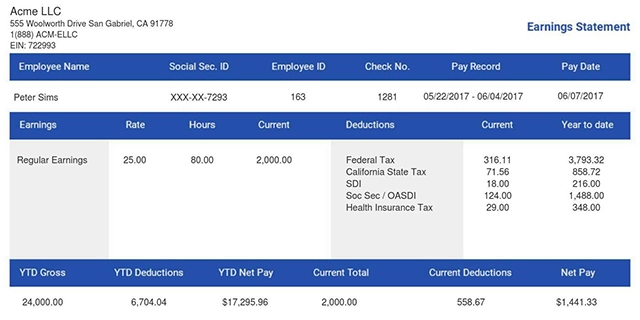The Difference Between Payroll Tax vs. Income Tax
Important information you need to know about payroll Tax vs. Income Tax. As a business owner, there are many things you need to be an expert at. That is because your business runs along with different systems, and you need to keep up. Meanwhile, you do not want to forfeit your earnings due to tax payments. That is why you must work with a tax professional to walk you through the kinds of tax (such as income and payroll tax rate) you should pay.
However, it is important to understand a few things across the tax system because it can confuse you. This article is created to equip you with the knowledge of payroll vs. income taxes, their examples, the difference between payroll and income taxes, how you can calculate them, income tax brackets, and some questions around them.
What is payroll tax?
Payroll tax is the tax system used by the United States to charge a certain percentage of the workers’ pay in other to foot some social security schemes. This tax is paid by deducting a certain amount from an employee’s salary. However, the employee is not the only one involved. The employer is also paying a part of the tax.
This tax is used as a support system for both Social Security and Medicare schemes. The Social Security scheme is used to provide for older people. At the same time, Medicare is an insurance scheme initiated by the federal government to alleviate health bills of both senior citizens and citizens with disabilities.
Social Security tax is deducted when you reach a certain threshold of income and is affected by the economic inflation rate. Medicare tax depends on the wages and salaries of individuals. Meanwhile, you pay the employee and the employer percentages of the tax as a self-employed person. This tax is imposed on employers and self-employed individuals in some states and cities. Some don’t impose it on employees.
Some of the payroll tax benefits are the funding of the benefits for disability, health care, retirement, and survivors of the deceased workers. Social Security and Medicare schemes are known to be the second-largest revenue source for the American government.
Also read: How Much Is Social Security tax?
What is income tax?
Income tax is the kind of tax you pay based on the amount of money you earn through various means. It includes money made from your day job and other sources of income. Those sources can be bank interest, gains from the stocks, and profits from stocks and property sales. You are solely responsible for paying your income tax.
You are either an employee or a self-employed individual, it is necessary to pay income tax. This is determined by filling out Form W-4, which is also regarded as Employee’s Withholding Certificate. Meanwhile, the percentage is not fixed, and the rate depends on how your income is growing. This is often removed quarterly.
The federal government is responsible for imposing income tax on individuals. However, some states stipulate paying income tax for people living and working in their cities. Meanwhile, income tax varies with each state. Consult a legal adviser in your state to have genuine information about income tax. Most of the revenue coming from income tax is used as public services funds for defense, education, and transportation.
This explains that income tax involves both employment taxes and unemployment taxes.
Also read: Are GoFundMe Donations Tax Deductible?
What are Income Tax Brackets?
Income tax brackets explain how much of your income can legally be taxed yearly by the Federal level. In some cases, it simply depends on how much income you earn during the tax year. The more money you make, the more taxes you pay. It applies to your income after deductions and exemptions have been made.
The percentages of income tax brackets for 2021 are as follows: 10%, 12%, 22%, 24%, 32% 35%, and 37%.
Payroll Tax vs. Income Tax
The major difference between payroll tax vs. income tax is the payer’s option. This means that who amongst the employer and the employee is paying the tax. As for payroll taxes, both the employer and the employee pay the taxes. In contrast, employers are the ones that pay income taxes. However, employers withhold both taxes when they conduct the payroll.
These taxes affect employees in different ways. Often, income taxes are the ones that affect employees a lot. That is because income taxes are on progressive charges while payroll taxes are regressive in rates. This means that the higher you earn, the lower you pay for payroll taxes. While for income taxes, you pay more taxes as you earn more. Payroll tax is deducted from your salary as an employee.
Payroll tax is simple to understand, but income tax is complex due to factors affecting its decision. These two taxes also serve different purposes. Payroll taxes are used to fund federal government schemes, while income taxes are used to fund purposes determined by the local government, state or federal government.
In summary, below is the summary of the important differences between income tax and payroll tax.
-
Payroll tax is charged at a flat rate, but income tax depends on the different sources of income.
-
Payroll tax has specific purposes it serves. Those purposes include Social Security and Medicare. As for income tax, the local, state, or federal government determines its purposes.
-
Income tax depends on the amount you earn as an employee. The higher you earn, the higher the tax you pay. On the other hand, the payroll tax is retrogressive. This explains that the higher you earn, the lower you pay for the tax.
-
The employer and the employee share the amount of tax to pay equally for payroll tax. Meanwhile, an employee pays the total income tax.
-
Payroll tax is the one known to help taxpayers directly in their contemporary lives. Income taxes are used indirectly.
Also read: A Full Guide on How to Calculate Income Tax On A Pay Check
Income tax and Payroll taxes 2021 Calculation
There are some sets of rules to follow while calculating income and payroll taxes 2021. They depend on the kind of tax you are paying for. Although there are some exceptions to the calculations. However, it is good to allow a tax accountant to take you through the calculations before processing the payroll. This enables you to know which calculations suit your business and employees.
This section details the comprehensive method of calculating income tax and payroll taxes in 2021.
How you can calculate Income tax and Payroll taxes 2021
The calculation of Federal Insurance Contributions Act (FICA) taxes is used as a case study in this section. We are using it to explain how you can calculate payroll tax using the FICA tax. This same process is used to calculate other payroll taxes.
-
Determine the periodic gross wages
Let us assume that you have an employee that is paid two times a month. That is equivalent to being paid 24 times in a year. Now, imagine his yearly salary is $144,000. For each pay period, he gets $6,000. Let us name him “John.”
Again, assume he has a month and a half gym membership for $50 and health insurance for $100. His gross wage is $6,150.
-
Calculate—in each payroll tax—the taxable wages
Different rules apply to wages that can be taxed based on the kind of taxes you are paying. Some taxes allow exemptions for some of your income, while some don’t. Either of the two knows which wages can be tax and which cannot be.
-
Know who’s paying the payroll tax
Solely your employer, while some are paid collectively by you— as an employee— and your employer pays some payroll taxes. That is, your employer pays the whole tax without deduction from your salary, or you both split it into equal half.
Federal Unemployment Tax Act (FUTA) tax is an example of payroll tax paid by the employer while an employer and an employee pay federal Insurance Contributions Act (FICA) taxes both.
-
Calculate payroll tax
Since you are aware of who is paying the payroll tax and how to pay it, calculate the tax and get it sorted.
How to calculate income tax
We will use this section to calculate federal income tax from an employee’s pay. However, understand that you can calculate your self-employed or business income tax too. This is calculated as tax liability.
Let’s get on it!
Calculating federal income tax for an employee
There are some factors you need to consider before withholding your employee’s income taxes. Some of those factors are earning, the number of dependents, your employee’s marital status, and others. These are things filled in the Form W-4 by your employee and are input in the payroll software.
It is important to inform your employees to use the IRS tax estimator before filing Form W-4. The estimator is a significant tool self-employed individuals can use to determine how much to pay as their federal income tax.
Also read: How to Review Your Paychecks Before Filing Income Taxes
Calculating federal income tax for a self-employed individual
Self-employed federal income tax is also regarded as a tax liability. This is the amount of tax that you will pay based on your business type. This taxing system depends on the legal structure of your business. It means that you either register your business as a sole proprietorship, partnership, corporation, or limited liability company (LLC).
Except you run your business as a corporation, you should calculate your tax every quarter. As a result, you won’t have to pay a huge tax after each fiscal year. Below are the steps on how to calculate your federal income tax as a self-employed individual.
-
Determine your yearly business income
The best way to do this is by calculating your income based quarterly. Then, you use it as a benchmark for a yearly estimate. Meanwhile, you should adjust your overall income if there is an increase in earnings or unexpected expenses throughout the year.
-
Determine your yearly deductible yearly expenses
You follow the same process as in the first step. You determine your possible expenses based on the first quarter expenses. You can then multiply it by four to get a hold of what your yearly estimate can be. Meanwhile, including the possible variations for the next quarter while making your estimation. Calculating your possible yearly tax is crucial despite paying every quarter.
-
Determine taxable income
Since you now know what your business income, expenses, and taxable income can be, include tax credits that you are eligible for during your estimation. That’s because the IRS operates with a graduated system. This means that you are taxed based on the levels of income. That is why yearly estimation is important.
-
Split into quarterly payments
Divide your estimated tax liability by four since you now have an idea of the amount. This is what you will use as your quarterly tax payments. However, you may end up not paying any income tax when your earnings and expenses show little to no difference.
FAQs
-
What is an example of a payroll tax?
Payroll taxes are taxes that your employers remove from your salaries and forward them to the state or federal government. They are taxes that serve specific purposes by the government. Examples of payroll taxes are Medicare tax, Social Security tax, and unemployment taxes.
-
What is the difference between payroll tax and income tax?
Payroll tax vs. income tax is the individual that is sending the payment. Payroll tax is paid either by your employer or by sharing equally between you and your employer. As for income tax, you are solely responsible for paying the taxes.
-
How do you calculate income tax?
Income taxes are calculated based on the kind of tax you are paying and how your business is structured. Most especially, it is calculated based on your business earnings and expenses. If there are no margins between the two, you may end up not paying income tax.
-
How do you determine the tax bracket?
The tax bracket is also referred to as the tax rate. Often, individuals with a low-income rate fall into this category. It is used to determine the percentage of tax to pay based on a progressive increase in your income. If you earn higher than last year, expect your income tax rate to increase.
-
How much can your employee earn before you can deduct tax from the pay?
There is no fixed amount of income your employee can earn before you start withholding taxes from your employee’s pay. Regardless of the amount they make, they start paying taxes immediately. However, this depends on the information on his Form W-4 and certain tax exemptions they are eligible for.
Also read: What Is FUTA Tax - All You Need To Know
Which tax do you qualify to pay for?
Now that you have a clear understanding of payroll tax vs. income tax, it is time you processed your tax payment. Whether you are a payroll taxpayer or an income taxpayer, you can now determine the tax amount and why you are paying. It is also important to produce a paystub for your own record-keeping, so that you know how much tax you'll have to pay when the time comes.















